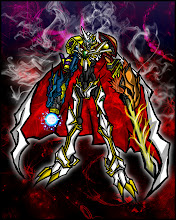In this tutorial we will learn how to
design a magazine cover in Photoshop. I usually design covers using
Photoshop and InDesign, but for this tutorial we will be using Photoshop
for everything. When you set out to design your own magazine cover
you’ll need to pay close attention to details and carefully lay out the
artistic aspect of it, working towards a well planned and complete
artistic concept. Taking the time to formulate a strong concept is
extremely important to the success of the magazine. I will take you
through the process of creating a cover and reveal techniques that
designers use to make their covers stand out.
Source : Inspiks
Final Image

Resources
Additional Resource, Includes “City.jpg” and “Lens Flare.jpg”
 Magazine Tut Additional Resource
Magazine Tut Additional Resource (4 bytes, 34,085 hits)
Files include: City and Lens Flare Images
Step 1
Create
a new document in Photoshop, 8.5×11 inches, 300dpi (for printing), RGB
color, (You can change the color mode to CMYK, after the image is
finished and flattened). Begin with a radial gradient, by double
clicking the background layer to activate the
Layer Styles menu, then apply a
Gradient Overlay.
 Color Codes:
Color Codes:
#f25cf4
#570472
#01101b

Step 2
Download and open the Lens Flare I created within
Knoll Light Factory plugin, drag it above the gradient layer and change the blending option to screen at 21%.

Open and drag the
City.jpg above the lens flare layer and change the blending mode to
Soft Light.

Step 3
Open the
Stock illustration: Planet drag it above the City.jpg layer, use a large, soft eraser bush and erase, the edges. Change the blending mode to
Screen.


Step 4
Duplicate the Lens Flare image and place the duplicate above the
“Stock illustration: Planet”. Give the lens flare
5% Gaussian Blur at
83% Opacity. Make sure the blending mode is still set to
Screen.

Step 5
Now
we will generate some Photoshop clouds to soften up the background a
little more. Create a new layer and fill it with black. Generate the
clouds by pressing Filter > Render > Clouds (make sure your colors
are set to black and white). I also used a large soft eraser brush to
erase the top of my clouds.

Change the Blending Mode to
Soft Light at 35% Opacity

Step 6
Now
we will create a subtle yellow glow. Create a new layer, draw a circle
with the Elliptical Marquee Tool and fill it with yellow #fbc531.

Apply a
Gaussian Blur with a
Radius of 114 pixels. Lower the
Opacity to 45%

Step 7
Open the
Model Face Handsome
from PhotoXpress, use the pen tool to cut out the model from the
background. If you do not know how to use the pen tool, you can learn
how by reading this
tutorial .

After you are done drawing your path with the pen tool. Create a selection from the path. Go to the
Path tab in the layers menu and click the
Load Path as Selection tool (Third symbol with the dotted lines).

Copy the model and paste him inside your magazine document, above all the other layers.

Use the
Brush Border Pack -27
from Media Melitia to paint on some dust and scratches. I used brush
number 15 in the package. Make a new layer above the model, then start
painting the dust and scratches.

Use
a large soft eraser to erase the border of the dust and scratches.
lower the opacity between 72%-82%. Duplicate the layer or paint other
around the model.

Step 8
Open the
Stock illustration: Planet from Stock.Xchng again and drag it above the dust and scratches, use a large eraser brush and erase the planet from the middle.

Change the blending mode to screen.

Step 9
Now
we will add some graphic flare to the cover for some extra pop! Create a
new layer, use the Rectangular Marquee Tool to draw a rectangular
selection. Add a gradient from white to transparent to the selection.

Erase the edge of the gradient with a large soft eraser brush.

Change
the blending mode of the gradient to Overlay. Rotate the gradient and
place it in selected areas over the model. I did this by duplicating the
layer over and over again and placing them until I feel I had balance
in the image.

Add
a color balance layer above all the current layers, with the settings
below, this will help to brighten the image and tie all the colors
together.


Step 10
First
drag in some margin lines at 0.25 inch to keep your text away from the
edge. Create a Masthead for your magazine, (The term “Masthead” is often
used to refer to the nameplate of a publication, its designed title as
it appears on its front page..). I created a simple but strong masthead
with Helvetica Inserat Roman Font. Place the Mast Head behind the model,
this overlapping technique, helps to create depth. I also included the
publication date and the mission statement of the magazine. (Before you
create your Masthead, research some magazines for inspiration on design
and placement.)

Step 11
Create Several story line titles around and over the model.
- Main Story Title. Here I used a large font to pull the readers eyes.
- Secondary Story Title. Here I used a smaller font, but color and a transparent box.
- Here I used different size fonts to separate Title and Sub Titles.

Step 12
Now we will finish up our magazine by adding a barcode. Download the
Free Vector Barcode Graphics by Airopia.

Final Image

Conclusion
You can play a little bit more with color to achieve different moods for the magazine, I hope you enjoyed it.




